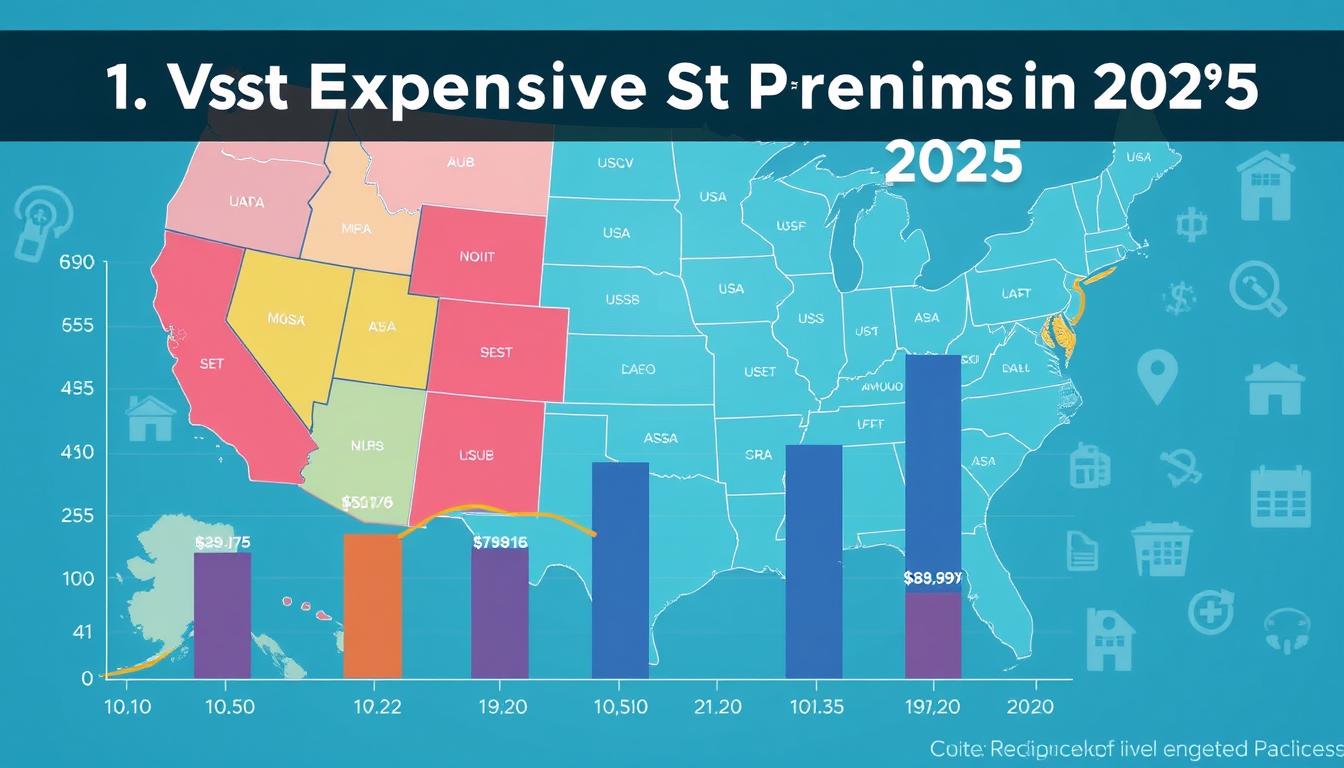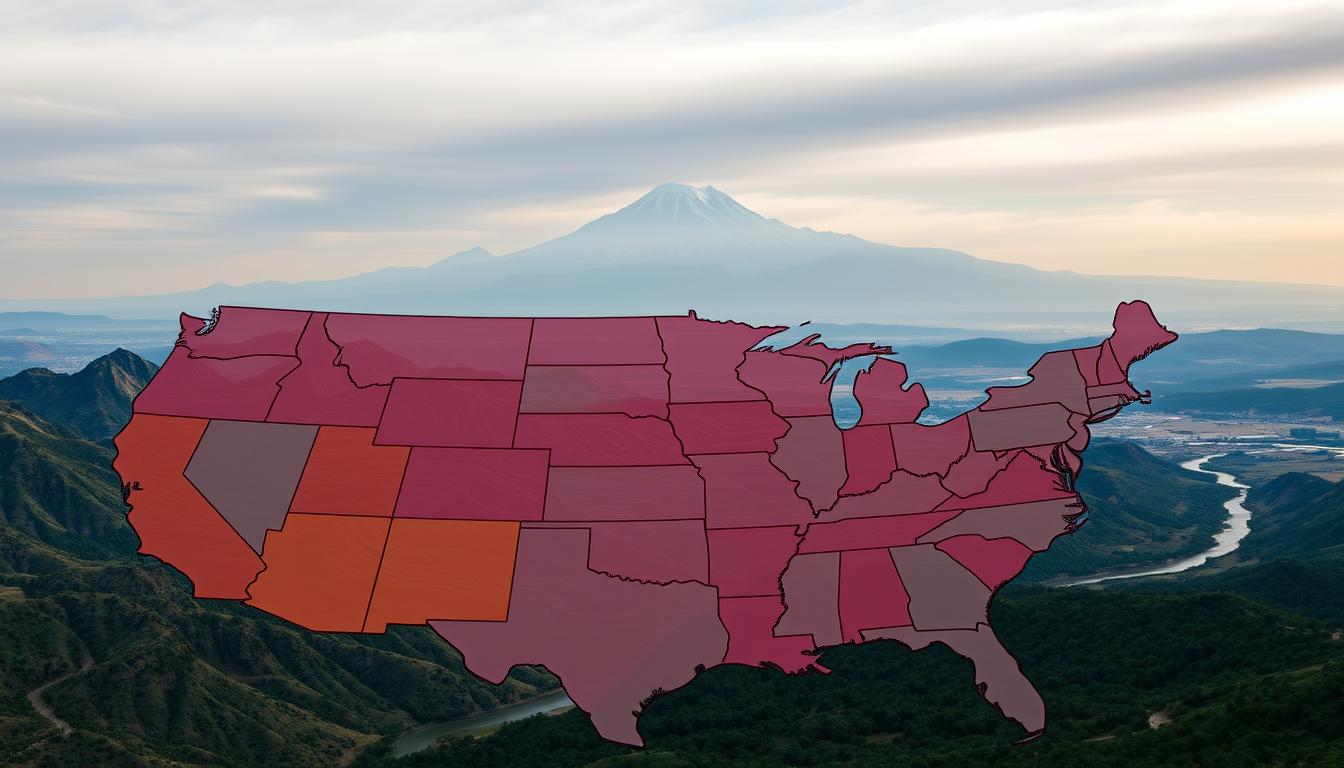You may have felt that pinch when a medical bill arrives or when you shop plans and prices feel like a foreign language.
This guide meets you there. It uses clear 2025 data so you can see how monthly premiums, subsidies, and local markets shape what you pay.
The national average for a 2025 benchmark ACA silver plan is $497 for self-only coverage. That number helps you compare real costs across the united states.
We highlight low-cost places like New Hampshire and Rhode Island, and contrast them with higher-priced areas such as New York and Vermont. You’ll learn how access, coverage rules, and marketplace choices affect affordability and your care options.
By the end, you’ll have a practical view of where rates land and how to use subsidies, timing, and plan types to protect your family’s health coverage now and in years ahead.
Key Takeaways
- 2025 benchmark silver average: $497 monthly for self-only coverage.
- Some states (New Hampshire, Rhode Island) show much lower premiums.
- Other areas (New York, Vermont) can be far more expensive.
- Public exchanges and subsidies change what you pay.
- Know age, location, and plan type to understand premium differences.
Why your state changes what you pay for health coverage right now
You can see big price swings when you compare plans across counties. Insurers set premiums using age, location, family size, tobacco use, metal tier, and plan type. That mix creates different rates even inside a single state.
PPOs usually cost more than HMOs because broader networks and out-of-network benefits raise provider bills. Only public exchanges unlock premium tax credits and cost-sharing reductions, so marketplace type matters.

- Local medical costs, network contracts, and the number of companies in your county affect prices.
- For 2025, 31 states use the federal marketplace while 19 states plus D.C. run their own platforms.
- Demographics, risk pools, and provider capacity drive year-to-year shifts in rates.
Understanding what you can control—plan design, network fit, and total outlay—helps you shop smarter. Re-shop each enrollment period to use new data and carrier changes to your advantage.
The Best States for Affordable Health Insurance
Your local benchmark premium in 2025 tells a simple story: where premiums are low and where they bite.
What the benchmark means
The benchmark is the second-lowest-cost silver plan in your rating area. It gives an apples-to-apples way to compare rates across the united states. Use it to estimate subsidy size and monthly outlay.

2025 snapshot and how to use it
New Hampshire posts the lowest 2025 average benchmark at $325. Other low averages include Minnesota ($363), Maryland ($365), Virginia ($372), and Rhode Island ($425).
Low benchmark premiums raise potential tax-credit value if your income qualifies. That can cut what you actually pay for insurance and care each month.
Affordability versus system performance
Affordability by premium does not equal top overall health outcomes. Commonwealth Fund rankings put Massachusetts, Hawaii, New Hampshire, and Rhode Island high on system performance.
Bottom line: weigh benchmark rates alongside deductibles, copays, and provider access so your plan fits both budget and care needs.
| Metric | Example states (2025) | Why it matters |
|---|---|---|
| Benchmark premium | New Hampshire $325; Rhode Island $425 | Drives subsidy size and monthly cost |
| System ranking | Massachusetts, Hawaii, New Hampshire, Rhode Island | Shows access, outcomes, prevention |
| Total cost of care | Varies by plan and state | Includes deductibles, copays, network limits |
Least expensive states for individual ACA premiums in 2025
Across the country, a handful of places show much lower monthly benchmark rates this year. Use this quick list to spot where benchmark silver premiums fall well under the national $497 average and why market structure matters.

New Hampshire: lowest average benchmark premium
New Hampshire posts the lowest 2025 benchmark at $325 for a 40-year-old nonsmoker. Competitive carriers and strict rate review help keep monthly costs down.
Minnesota and Maryland: competition and managed costs
Minnesota ($363) and Maryland ($365) use active oversight, reinsurance, and solid insurer participation to stabilize rates. That makes marketplace coverage more accessible to many people.
Virginia and Indiana: mid-Atlantic and Midwest value
Virginia ($372) and Indiana ($382) combine narrower networks and balanced risk pools. Those choices help lower premiums while preserving essential coverage and access to local care health providers.
Michigan, Arizona, Nevada, Rhode Island, Iowa: rounding out low-cost options
Michigan ($404), Arizona ($410), Nevada ($414), Rhode Island ($425), and Iowa ($429) all sit below the national benchmark average. Market design, enrollment patterns, and provider competition drive those rates over years.
- Shop near the benchmark: comparing silver plans close to the benchmark can maximize premium tax-credit value if you qualify.
- Check plan details: deductibles, copays, and networks change your total cost even in low-rate markets.
- Watch trends: multi-year data hint whether low rates will persist as carriers and enrollment shift.
| State | 2025 Avg Benchmark ($) | Key driver | Notes |
|---|---|---|---|
| New Hampshire | $325 | High competition, rate review | Lowest benchmark; strong carrier participation |
| Minnesota | $363 | Regulation, reinsurance | Stable rates, wider access |
| Maryland | $365 | Active oversight | Managed costs, steady enrollment |
| Virginia | $372 | Narrow networks, pooled risk | Mid-Atlantic value |
| Indiana | $382 | Plan design, market balance | Midwest affordability |
Most expensive states for individual ACA premiums in 2025
Some markets in 2025 carry far higher monthly benchmark premiums than most of the country. That gap reflects market size, provider cost, and carrier participation more than plan design alone.
Vermont and Alaska show the highest averages: Vermont $1,277 and Alaska $1,045. Small populations and remote care delivery raise per-member costs and create volatility in risk pools.
West Virginia and Wyoming
West Virginia ($919) and Wyoming ($871) face access challenges. Fewer hospitals and specialists across large rural areas increase per-person spending and push up marketplace rates.
New York and Connecticut
New York ($790) and Connecticut ($693) can carry higher premiums even with strong systems. Urban cost pressures, richer plan designs, and utilization patterns help explain those numbers.
South Dakota, Nebraska, D.C., Montana
South Dakota ($619), Nebraska ($600), District of Columbia ($578), and Montana ($554) sit above many peers due to demographics, provider pricing, and narrow networks.

- Tip: gross premiums aren’t final—tax credits on a public exchange can cut your net cost considerably.
- Shop strategy: consider HMOs or narrower networks, check total cost of care, and watch state rate filings for new carriers or reinsurance moves.
| State/group | 2025 avg benchmark ($) | Main driver | What to check |
|---|---|---|---|
| Vermont | $1,277 | Small market, high delivery costs | Carrier participation, reinsurance signals |
| Alaska | $1,045 | Remote care, high transport & facility costs | Network breadth, subsidy eligibility |
| West Virginia / Wyoming | $919 / $871 | Access limits, rural provider shortages | Local provider access, total out-of-pocket |
| New York / Connecticut | $790 / $693 | Urban costs, richer plan designs | Plan utilization patterns, premium tax-credit impact |
How the Affordable Care Act and tax credits change affordability
Through 2025, subsidy rules can cap your premium burden and change which plan makes sense. Premium tax credits limit what you pay for a benchmark silver plan to no more than 8.5% of household income. That cap directly affects your monthly outlay and access to care.
Premium tax credits at 8.5% of income through end of 2025
Tax credits reduce gross premiums when the benchmark silver exceeds 8.5% of your income. You can apply the credit to any metal tier on a public exchange to lower your net premium.
Cost-sharing reductions and metal tiers
Cost-sharing reductions (CSRs) only work with silver plans. If your income qualifies, CSRs cut deductibles and copays to improve affordability and help you use care sooner.
Why only public exchanges unlock subsidies
Only plans bought on HealthCare.gov or state marketplaces qualify for premium tax credits and CSRs. Buying the same plan direct from companies off-exchange often means no subsidy.
- Drivers of your rates: age, location, family size, tobacco use, metal tier, and plan type.
- Keep Marketplace income current—mid-year changes can alter your credit and tax reconciliation.
- Enroll during Open Enrollment or a Special Enrollment Period to claim eligible help for the year.
Medicaid expansion’s impact on access, affordability, and outcomes
Expansion choices have changed how many low-income adults get timely care across much of the country. When a state expands Medicaid, more people gain coverage and can use preventive services sooner.

What expansion did: 39 states plus D.C. adopted optional growth under the ACA. That shift unlocked federal funds and raised enrollment among adults, children, and pregnant people.
States that expanded generally rank higher on access and affordability
Many top-performing systems expanded, and data show better access to primary care and lower uninsured rates. Expansion also reduces uncompensated care at hospitals and stabilizes local provider finances.
Eligibility levels and who qualifies
Thresholds vary widely by state. Some set low adult limits while others include broader child and pregnancy coverage. Check your local program rules to see if you or family members meet income-based criteria.
- Higher FMAP often links to lower household income and more reliance on Medicaid.
- Public health investments plus expansion cut avoidable utilization and improve overall health.
- Expansion can indirectly lower individual market premiums by improving risk pools.
Takeaway: your state’s policy choices affect access to care now. Review eligibility, enroll if qualified, and use available programs to protect finances and long-term health.
| Metric | Effect | Action for you |
|---|---|---|
| Enrollment | More people covered | Check state enrollment portals |
| Uncompensated care | Declines | Hospitals stabilize, better access |
| Premiums (individual market) | Can fall indirectly | Shop marketplace and compare |
Best overall health care system rankings are not the same as cheapest premiums
System performance and price move on different tracks. Rankings capture access, prevention, treatment, outcomes, and equity. That explains why top performers can still carry higher plan costs for some people.

Commonwealth Fund places Massachusetts, Hawaii, new hampshire, and rhode island at the top across 50 measures. Mississippi sits at the bottom. Policy choices like Medicaid expansion and primary care investment drive those high scores.
Still, marketplaces reflect local provider pricing, carrier competition, and enrollment patterns. New york often ranks well on system measures yet lands among higher-premium markets. That gap shows quality and pricing are different things.
“Strong system scores mean better access and outcomes, but not always lower monthly premiums.”
- Use system rankings to assess access and long-term value.
- Compare those results with premium data so you balance cost and care.
- Look for public health investments that may reduce cost growth over time.
| Metric | Example | Why it matters |
|---|---|---|
| System ranking | Massachusetts, Hawaii | Access, outcomes, equity |
| Marketplace price | New york high | Provider fees, carrier supply |
| Policy driver | Medicaid expansion | Improves coverage and access |
Low-income coverage landscape: where Medicaid and CHIP go further
Access to stable, low-cost coverage matters most when income is tight. Medicaid and CHIP fill gaps that marketplace plans can’t for many families. How well they work depends on eligibility rules, enrollment systems, and federal support levels.
HealthCareInsider ranked states and D.C. across Cost, Access, and Quality using 13 metrics. Top overall performers include Connecticut, new york, California, Massachusetts, Minnesota, and D.C. Bottom performers include South Dakota, Oklahoma, Georgia, Kansas, Idaho, and Wyoming. Those rankings reflect real differences in how programs reach people.

HealthCareInsider rankings across Cost, Access, and Quality
Rankings combine eligibility levels for adults, children, and pregnant women with enrollment per capita, FMAP, and quality measures. Higher-ranked states generally deliver better health care access and lower financial strain for low-income households.
High FMAP states and what it means for you
States that receive more federal matching dollars often expand services and simplify enrollment. That boost widens coverage, improves primary care access, and supports public health programs that reduce avoidable hospital use.
- You’ll see which states excel when cost, access, and quality are measured together, with leaders like Connecticut and new york.
- Breadth of eligibility and higher FMAP often translate into stronger coverage and easier access care for families.
- Metrics such as children’s eligibility, pregnant women’s thresholds, and Medicaid enrollment per capita show practical impact on household access.
| Metric | What it shows | Example impact |
|---|---|---|
| Eligibility breadth | Who qualifies | Broader rules = more people covered |
| FMAP level | Federal match rate | Higher FMAP funds outreach and services |
| Enrollment per capita | Program reach | Higher enrollment = better system stability |
“Stronger low-income coverage supports overall health and can stabilize individual market risk pools over time.”
Practical tip: check your state’s eligibility rules, apply if you qualify, and plan how Medicaid or CHIP can pair with marketplace options if income changes over years.
Marketplace dynamics that drive price differences across states
Market structure, provider supply, and local utilization patterns shape why premiums feel higher in some regions.
Carrier competition matters. When more companies enter a market, rates tend to fall. Where a few firms dominate, prices often rise because there is less price pressure. Small group trends and employer choices also change carrier appetite to enter your region.

Network design and regional risk
PPO plans typically carry higher premiums than HMO plans. PPOs pay more for out-of-network access and broader choice, which raises claims costs.
Regional risk pools concentrate health risks differently across urban and rural areas. Rural markets often face access limits and higher negotiated fees per service.
Urban versus rural access and utilization
Avoidable utilization, such as preventable ER visits, drives up total cost and filters into pricing. Strong primary care reduces that pressure and supports lower community rates.
| Driver | Effect on rates | What you should watch |
|---|---|---|
| Carrier competition | Lower rates with more companies | New entrants in filings |
| Network type (HMO/PPO) | PPO = higher premiums | Network breadth and copays |
| Rural access | Higher fees, limited providers | Provider contracts and service gaps |
| Utilization patterns | Higher avoidable use raises costs | Primary care access programs |
Shopping tip: pick plans with efficient networks and care management. Review rate filings and local data to anticipate next year’s moves and protect your coverage.
How to shop smart by state on the ACA Marketplace
Start by pinpointing your local benchmark silver premium so you know the subsidy baseline in your rating area.
Compare benchmark versus off-benchmark plans by metal tier: use the benchmark as your reference. Then check off-benchmark silver options, bronze, and gold to see how premiums trade off with deductibles and copays. Focus on total annual cost, not monthly price alone.
Estimate tax credits from your household income and family size. Remember: premium tax credits reduce costs when the benchmark exceeds 8.5% of income through 2025. Only plans bought on public exchanges qualify for those credits and for cost-sharing reductions.

Use income-based subsidies and state marketplace features
Thirty-one states use the federal marketplace; 19 plus D.C. run state-based platforms with unique tools. Some state sites offer standardized plan displays or extra decision support that can save time and reduce confusion.
- Start local: find your benchmark silver price and list two finalist plans.
- Check networks and formularies: confirm your doctors and prescriptions are included.
- Adjust for income changes: update your application so credits match expected tax outcomes.
| Step | What to check | Why it matters |
|---|---|---|
| Benchmark silver | Local premium value | Sets tax credit baseline and your net cost |
| Metal tier comparison | Deductible, copays, out-of-pocket max | Determines real cost based on expected care use |
| State marketplace tools | Standardized plans, calculators | Saves time and improves coverage choices |
| Enrollment timing | Open or Special Enrollment | Avoids gaps and locks in subsidies |
Final tip: run a side-by-side total-cost calculation for two finalist plans. Include premiums, expected visits, prescriptions, and estimated tax credits. That gives you a clearer view of affordability and health care access where you live.
Leveraging employer-funded HRAs to cut your costs
Employer-funded HRAs can trim your monthly burden by reimbursing many out-of-pocket health expenses tax-free. They work alongside market coverage or group plans to lower what you actually pay each month.
What HRAs can reimburse:
- Individual health insurance premiums and some marketplace plan costs.
- Prescription drugs and qualifying over-the-counter medicines.
- Mental health counseling, doctor visits, specialist care, and emergency services.
How allowances, rollovers, and eligibility work in practice
Employers set monthly allowances and define eligible expenses. Unused amounts may roll over month-to-month but do not transfer beyond your employment or the plan year.
HRA funds remain the employer’s; if you leave, unspent dollars typically stay behind. Stand-alone HRAs can pair directly with individual market coverage instead of a group option.

| Feature | How it helps you | What to confirm |
|---|---|---|
| Premium reimbursements | Reduces your net monthly premium cost | Whether stand-alone HRA covers marketplace plans |
| Everyday care expenses | Tax-free payback for visits and drugs | List of eligible items and substantiation rules |
| Allowances & rollovers | Predictable monthly support; some rollover flexibility | Rollover limits, plan year rules, ownership of funds |
| Coordination with group plans | Can supplement or replace group coverage | Class rules, eligibility, and impact on subsidies |
Quick checklist
- Ask your employers whether a stand-alone HRA is offered and which expenses qualify.
- Document claims promptly and use any substantiation portal to speed reimbursements.
- Plan spending if you expect a job change—unused funds typically do not move with you.
- Confirm how HRA reimbursements affect any marketplace subsidies or tax filing.
“HRA reimbursements are generally tax-free, making them a powerful tool to improve coverage affordability and smooth health care costs.”
QSEHRA and ICHRA: choosing the right stand-alone HRA for your situation
Small employers can use stand-alone HRAs to give workers reliable premium help without running a group plan.
QSEHRA for small employers
QSEHRA works for employers with fewer than 50 full-time equivalents. It has annual IRS caps and can reimburse premiums and eligible out-of-pocket costs.
If a QSEHRA is affordable in a month, you cannot claim premium tax credits for that month. If it is not affordable, you may keep credits but must reduce them by the allowance.
ICHRA flexibility
ICHRA has no maximum contribution limits and lets companies vary offers by employee class. It requires qualified individual coverage to receive reimbursements.
If an ICHRA is affordable, you must waive premium credits. If it is unaffordable and you opt out, you can keep credits.

- Compare QSEHRA caps versus ICHRA design to match your workforce and budget.
- Verify monthly affordability tests using your household income and plan costs.
- Communicate allowances clearly so employers and staff avoid surprises during Open Enrollment.
| Feature | QSEHRA | ICHRA |
|---|---|---|
| Employer size | <50 FTE | Any size |
| Contribution limit | IRS caps | No max |
| Subsidy effect | May reduce credits | Must waive if affordable |
“Run affordability checks before offering an HRA to protect employees’ net premiums and tax outcomes.”
States to watch: when high premiums meet strong access and quality
Some regions carry steep monthly rates yet deliver unusually reliable access and clinical quality. You’ll watch markets where higher list premiums pair with strong system rankings so you can weigh price against outcomes.
Examples to follow: new york shows high average premiums but strong overall health metrics. new hampshire and rhode island combine low benchmark rates with high performance, offering models other areas may copy.
Policy tools that often predict positive moves include rate review, targeted reinsurance, and primary care investment. Urban/rural mix, provider competition, and network design also tilt pricing without necessarily harming care quality.

- Watch signals: carrier entries/exits, reinsurance waivers, Medicaid eligibility shifts, and enrollment trends.
- Shop strategy: use tax credits, CSR eligibility, and HMO networks to blunt high list prices.
- Consider a gold plan if you have steady, high utilization—net cost can beat frequent deductibles.
“Monitor hospital and physician quality, then match plans to higher-value providers.”
| Signal | Why it matters | Action |
|---|---|---|
| Carrier entry | Can lower premiums | Re-shop at open enrollment |
| Reinsurance | Stabilizes affordability | Watch filings |
| Medicaid changes | Affects coverage & risk pools | Check eligibility updates |
Data-driven method: sources and measures behind these state rankings
We combined public datasets and careful normalization so you can trust what the numbers mean.
KFF premiums by state and metal tier (2025)
KFF provides state-level premiums and metal-tier breakdowns that anchor our affordability comparisons. We used the benchmark silver as a consistent reference to estimate tax credits and net monthly cost across your state.
Commonwealth Fund’s 50-measure system performance index
The Commonwealth Fund evaluates access, outcomes, equity, prevention, and avoidable use across fifty measures. We mapped those scores to each state to separate system performance from raw premium rates.
Medicaid and CHIP metrics shaping low-income coverage
HealthCareInsider’s 13-metric framework—eligibility thresholds, enrollment per capita, and related program measures—helped us assess low-income coverage strength and how it changes marketplace risk pools.
- We reconciled KFF premiums, Commonwealth Fund scores, and Medicaid/CHIP metrics into a single table for cross-state comparison.
- Normalization used population-adjusted figures and the benchmark silver to allow consistent rate comparisons across regions and years.
- Year-over-year checks flagged stable trends versus one-off anomalies so you can see persistent patterns.
| Source | Primary measure | Use in our method |
|---|---|---|
| KFF | Premiums by metal tier | Benchmarks and subsidy estimates |
| Commonwealth Fund | 50-measure index | System performance and equity lens |
| HealthCareInsider | 13 low-income metrics | Medicaid/CHIP program strength |
“Clear methods matter: you should be able to match our sources and reach the same conclusions.”
Limitations and verification: timing differences, reporting lags, and incomplete filings can affect a single-year rank. Use state marketplace tools and carrier filings to verify current rates and tax credits for your household.
What this means for you and your family in the United States
Small differences in local rates and tax credit rules often decide whether a plan fits your budget. Premiums vary widely by state in 2025, and public exchanges can cap costs at 8.5% of income for a benchmark silver plan.
Act now: check your local benchmark, estimate tax credits, and compare total costs so your family’s health coverage stays affordable.
Low-income families may qualify for Medicaid or CHIP depending on state rules. Verify eligibility in your state if income changes to keep kids and pregnant family members covered.
- Decide between silver with CSRs or gold if you use a lot of care, or bronze for protection against big bills.
- Use employer HRAs to reimburse premiums and out-of-pocket costs when available.
- Know Open Enrollment dates and Special Enrollment triggers so you act at the right time.
| Task | Why it matters | Quick action |
|---|---|---|
| Benchmark & credits | Sets net premium | Estimate using household income |
| Network check | Protects access | Map doctors and prescriptions |
| Income updates | Affects tax credits | Update Marketplace when income changes |
“Plan your budget for premiums and out-of-pocket costs, and use public health resources to fill gaps.”
Conclusion
This year’s premium map is wide, yet practical steps let you secure affordable care with confidence.
You’ve seen how location across the united states changes list prices and creates large variation in 2025 benchmark averages, including a $497 national midpoint.
Act now: check your local benchmark, estimate credits on a public exchange, compare two finalist plans, and ask whether an employer HRA (QSEHRA or ICHRA) can add monthly support.
Small moves—timing enrollment, verifying networks, and using public subsidies plus employer help—deliver real addition to your budget and protect access to care health services in years ahead.
Final note: re-shop annually and use available tools to keep affordable care within reach across the country.